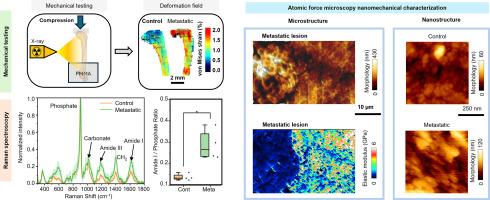转移性骨病变的微观结构提示肿瘤介导的骨矿化改变。
IF 3.6
2区 医学
Q2 ENDOCRINOLOGY & METABOLISM
引用次数: 0
摘要
乳腺癌、前列腺癌和肺癌细胞经常转移到骨骼,导致骨骼微观结构的破坏。本研究利用显微ct成像、数字体积相关(DVC)和原子力显微镜(AFM)纳米力学测试来检测转移性肺癌细胞累及小鼠长骨(胫骨)的力学性能变化,从全骨尺度到微观结构水平。此外,我们还研究了转移性侵袭如何在纳米尺度上改变骨中羟基磷灰石纳米晶体的形态。使用拉曼光谱评估转移灶内的生化成分,并与AFM力学测试数据相关。我们的研究结果表明,肺癌骨转移诱导区域特异性脱矿和微结构改变,这可能取决于肿瘤侵袭前的局部骨基质结构。特别是,肺癌细胞转移区的板层皮质骨在矿化胶原原纤维内部和之间表现出脱矿,以及孔隙度增加。在胫骨嵴区域,自然缺乏有组织的板层结构,脱矿以空间不均匀的方式发生,导致形成具有不同机械刚度的群集区域。这些局部矿物质和有机物含量的差异,以及微观结构组织,可能会导致荷瘤骨机械完整性的空间异质性,导致机械强度受损。这些发现为转移过程中肿瘤-骨微环境的微结构改变提供了新的见解。本文章由计算机程序翻译,如有差异,请以英文原文为准。

The microstructure of metastatic bone lesions suggests tumor mediated alterations in bone mineralization
Breast, prostate and lung cancer cells frequently metastasize to bone, leading to disruption of the bone microstructure. This study utilized mechanical testing coupled with micro-CT imaging, digital volume correlation (DVC), and atomic force microscopy (AFM) nanomechanical testing to examine the mechanical property variations in mouse long bones (tibia) with metastatic lung cancer cell involvement, spanning from the whole-bone scale to the microstructural level. In addition, we also investigated how metastatic invasion alters the morphology of hydroxyapatite nanocrystals in bone at the nanometer scale. The biochemical composition within metastatic lesions was assessed using Raman spectroscopy and correlated with AFM mechanical testing data. Our results demonstrate that lung cancer bone metastasis induces region-specific demineralization and microarchitectural alterations, which likely depend on the local bone matrix structure before tumor invasion. In particular, lamellar cortical bone in the lung cancer cell metastatic region exhibits demineralization both within and between mineralized collagen fibrils, as well as increased porosity. In the tibial crest region, which naturally lacks organized lamellar architecture, demineralization occurs in a spatially nonuniform manner, resulting in the formation of clustered regions with varying mechanical stiffness. These localized differences in mineral and organic content, along with microstructural organization, may contribute to spatial heterogeneity in the mechanical integrity of the tumor-bearing bone, leading to impaired mechanical strength. These findings offer new insights into microstructural alterations within the tumor–bone microenvironment during metastatic progression.
求助全文
通过发布文献求助,成功后即可免费获取论文全文。
去求助
来源期刊

Bone
医学-内分泌学与代谢
CiteScore
8.90
自引率
4.90%
发文量
264
审稿时长
30 days
期刊介绍:
BONE is an interdisciplinary forum for the rapid publication of original articles and reviews on basic, translational, and clinical aspects of bone and mineral metabolism. The Journal also encourages submissions related to interactions of bone with other organ systems, including cartilage, endocrine, muscle, fat, neural, vascular, gastrointestinal, hematopoietic, and immune systems. Particular attention is placed on the application of experimental studies to clinical practice.
 求助内容:
求助内容: 应助结果提醒方式:
应助结果提醒方式:


